Altra Mont Blanc BOA
Test Location: Marin, CA
Test Duration (so far): 75 miles
Stated Stack Height (Men’s): 30 mm (heel) / 30 mm (forefoot)
Stated Heel-to-Toe Drop: 0 mm
Stated Features:
- Midsole made from Altra’s premium EGO MAX foam for lightweight cushioning
- A Vibram “MegaGrip LiteBase” outsole for traction on any terrain
- Altra’s “Balanced Cushioning” platform for better form
- Altra’s “Standard FootShape” fit for comfort, stability, and foot security at higher speeds
- BOA’s “Fit System” and “PerformFit Wrap” for a customizable fit
Stated Weight per Shoe (US Men’s Size 9): 317 g / 7.3 oz
Blister Measured Weight per Shoe (US Men’s Size 8.5):
- Shoes + Laces: 268 g (left) & 273 g (right)
- Insoles: 16 g (left) & 14 g (right)
- Total: 284 g (left) & 287 g (right)
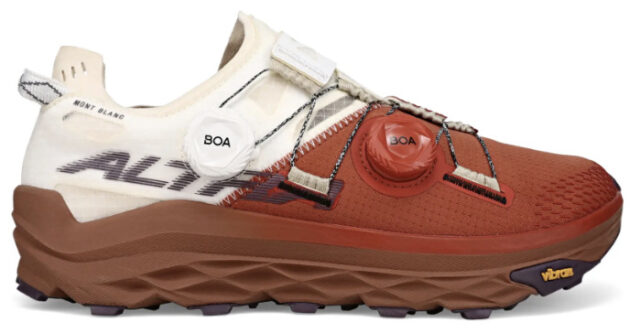
MSRP: $210
Size Tested: US Men’s 8.5 / EU 42
Reviewer: 5’5”, 130 lbs / 165 cm, 59 kg
Intro
For anyone who dabbles in mountain sports, recreating in the shadow of (or atop) the Mont Blanc massif in Western Europe is likely on the bucket list. The behemoth mountain range that spans across multiple countries in the Alps boasts a variety of routes up, down, and around it, along with a diverse array of trails ranging from technical singletrack to buffed-out gravel paths. It also happens to be the site of trail running’s superbowl, the UTMB (Ultra Trail du Mont Blanc), which laps the mountain in late August each year.When word got out that Altra’s newest trail racing shoe would adopt the namesake of the aforementioned Mont Blanc, Altra fans waited with bated breath for more details to emerge. The company hinted that the Mont Blanc shoe would give runners a true trail-racer that could handle ultra distances on a variety of terrain, all in a lightweight package equipped with Altra’s plush “EGO MAX” midsole foam that’s used in their higher-end models like Altra Torin, and a super grippy Vibram “Megagrip LiteBase” outsole. However, the original Mont Blanc’s introduction was rocky (no pun intended), with many runners expressing dissatisfaction with the shoe’s overall fit, citing difficulties achieving the lockdown needed for a relatively high-stack trail shoe.
With the Mont Blanc BOA, Altra attempts to correct the standard version of the shoe’s flaws by swapping out its traditional lacing system for BOA’s “Fit System,” a laceless configuration that uses two lightweight dials to control two separate zones of the foot — one at the ankle / heel collar, the other centered more toward the midfoot. Altra claims that this alternative lacing system offers a much more precise fit and the convenience of tuning the Mont Blanc BOA on the go. In this review, we’ll address the Mont Blanc BOA’s overall performance and whether or not the addition of BOA’s Fit System adds or subtracts from the shoe.
Trail Racer vs. Trail Shoe
Whenever a footwear company releases shoes that are marketed specifically for race day, this can generally mean a few things. Performance-oriented models will likely be lighter, have a snugger fit, and will be made with premium materials that complement the aforementioned qualities. Oftentimes, shoes in this category will sacrifice a bit of durability if it means getting you to the finish line just a bit faster.
In the past, Altra has made attempts at putting out trail running shoes that would check enough of these boxes to deem them “race day ready.” There was the King MT, which went through two iterations (three, if you consider Altra’s 0.5 iterations a full update) and was a favorite of obstacle course racers (OCR) due to its deep-lugged Vibram outsole, drainage ports, and a velcro strap that locked down the midfoot. The Achilles’ heel of this shoe ultimately was its lack of durability, which was due largely in part to the thin mesh overlays Altra insisted on using for the shoe’s upper, which breathed well but had a tendency to blow out very quickly.
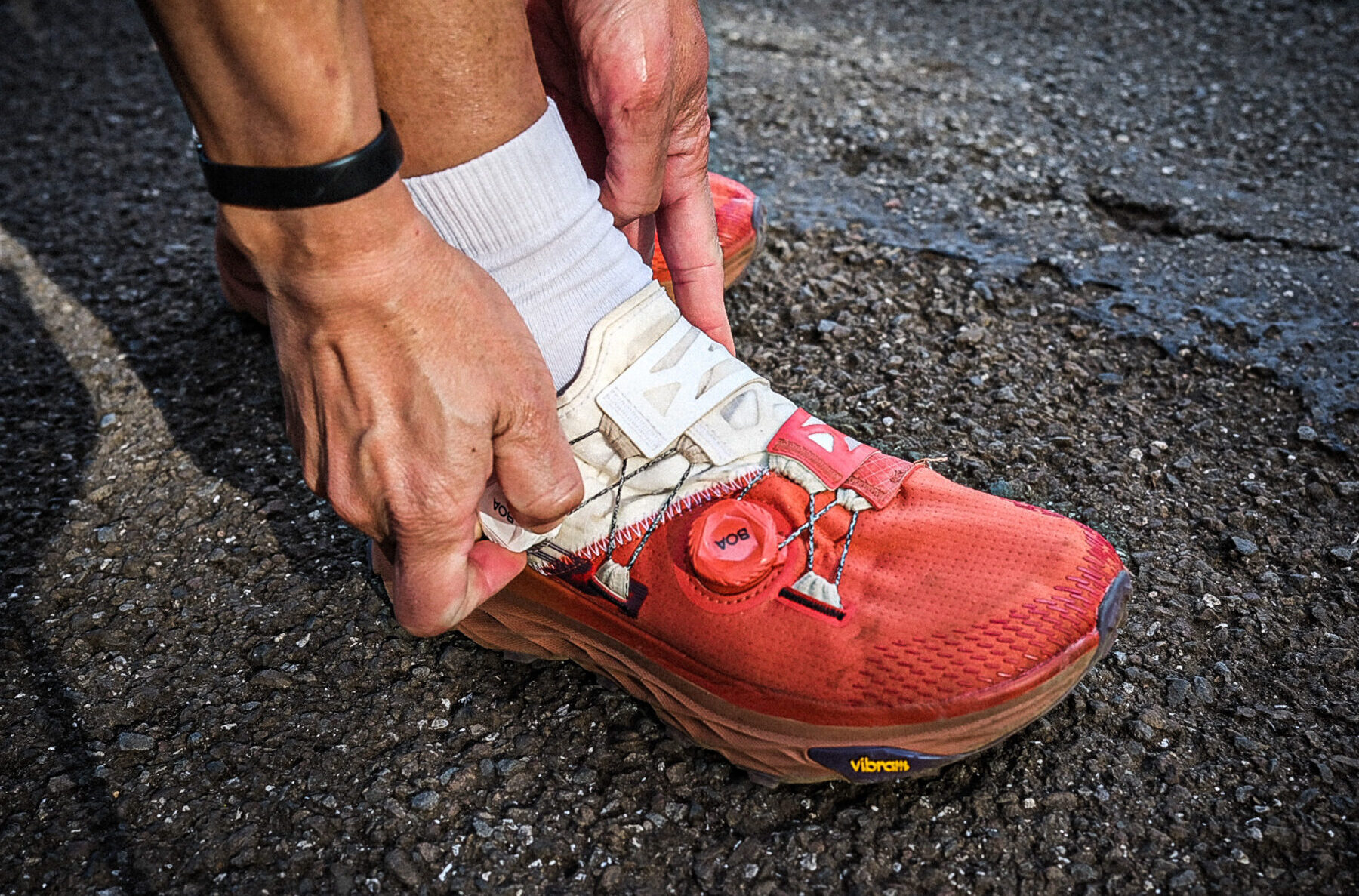
There’s also the Altra Superior, a lightweight trail shoe that encouraged folks to run fast across different terrain and conditions. The shoe also featured a removable rock plate in the form of a flexible piece of plastic that could be placed between the insert and the shoe itself. The Superior 4 was my shoe of choice for most of my racing season during the year it was released, something I wore for both shorter trail races in wet conditions and 50ks on varied trails.
Based on its evolution and expansion over the years, Altra’s trail lineup was bound to receive a race-oriented, ultra-distance, mountain shoe at some point (the Superior and King MT were both pretty minimally cushioned models). They needed an option that their athletes and devotees could use for performance, a model optimized for speed and comfort on rugged terrain. On paper, the Mont Blanc BOA looked to be exactly that.
Fit
As with any shoe, but especially given the Mont Blanc BOA’s steep price point, I’d urge prospective buyers to try the shoe on in person, if possible. I’ll provide some context about my own foot type and fit preferences, but your experience might differ wildly depending on your own. I’ve worn Altra shoes for years now and prefer their broader lasts for my wide, high-volume feet. As a runner with a pretty pronounced forefoot strike, I also look for shoes with a secure-fitting midfoot, especially if I plan on wearing them for higher-intensity runs or over long distances. I’ve worn several shoes equipped with BOA’s Fit System in the past, so I went into this review with high hopes.
The first iteration of the Mont Blanc had a traditional lacing system and was criticized mainly for its unstructured heel, which could cause the shoe to feel unstable for a lot of folks. I was able to test a pair on a 14-mile trail run during which I nearly rolled my ankle three times, not to mention the lack of surefootedness I felt descending on even very tame fire roads. However, the “Standard Footshape Fit” Altra used in the Mont Blanc (between “Original,” their widest, and “Slim,” their narrowest), as well as the shoe’s comfortably fitting upper, were some positives that made me optimistic that the addition of a BOA Fit System could more than make up for the original shoe’s faulty heel design. The Standard Footshape Fit is fairly average in terms of volume, if not slightly higher-volume, apart from Altra’s signature toe box, which is on the wider end. I really enjoyed how this alternative lacing system was used on the Speedland SL:PDX, which has set the standard for how I like my trail shoes to fit (i.e., highly tunable and relatively wide in the forefoot).
In my first run in the Mont Blanc BOA, I noticed how the changes to the shoe’s closure system already solved most of the problems faced by the lace version, especially when it came down to foot lockdown. In this shoe, BOA’s Fit System uses two micro-adjustable dials that work together with three independent wraps layered over the medial frontfoot, midfoot, and forefoot, dubbed “PerformFit Wrap.” Layering like this hugs the foot much more than traditional laces, allowing for an extreme level of precision. And because the dual-dial system can be controlled zonally, it opens up the shoe to a broader range of foot types and more fine-tuning. Runners with wide feet will be able to relax tension across the forefoot while tightening the shoe’s upper dial to prevent heel slippage. Runners with narrower feet should have no problem achieving a snug fit by virtue of the PerformFit Wrap, which can be tightened pretty securely at the midfoot and ankle. Of course, the only way to know for sure is to try it on for yourself.
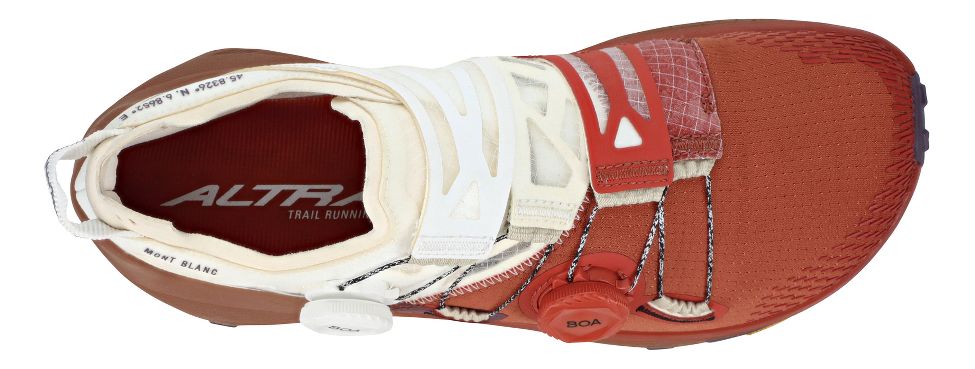
An additional benefit of adding the BOA Fit System to the Mont Blanc is the ease with which the shoe’s fit can be adjusted on the fly. My feet tend to swell on longer efforts, so in the past, I’d have to stop and retie my shoes, something I didn’t love to do in the middle of a race. The dual dials allowed me to tighten / loosen the shoe’s fit instantaneously. However, unlike the SL:PDX, which has dials that can be toggled either way, the dials on the Mont Blanc BOA can only be tuned to increase tension. In order to back off tightness, the dials need to be fully released first and then re-tensioned to your preferences.
So I’m clearly a fan of BOA’s Fit System, but does its addition to the Mont Blanc correct any of the laced version of the shoe’s problems? In short: yes. I found that by reducing all the jostling and slippage of my foot during runs, the precision conferred by the BOA dials and PerformFit Wrap compensated for the shoe’s insubstantial heel collar. While that’s reassuring, the fact remains that the heel collar is still a weak point, something I’m keeping my eye on as I spend more time in the Mont Blanc BOA.
Weight
The Mont Blanc BOA is not featherlight by any means, nor is that its primary goal. To deliver on the promise of being a long-distance shoe that performs well across rugged terrain, there needs to be some substance to it. The shoe carries most of its weight in its 30 mm midsole and lugged outsole, as to be expected, but the fact that the BOA Fit System adds a reported 37 grams to the laced version of the Mont Blanc shouldn’t be ignored. Yes, it’s a race shoe (a category where low weight is a priority), but it’s a long-distance race shoe for rugged terrain. For reference, here’s how the Mont Blanc BOA’s stated weight compares to the stated weights for some other similar models. All weights are based on a US Men’s Size 9.
240 g / 8.5 oz — Hoka Zinal
255 g / 9.0 oz — Saucony Endorphin Edge
264 g / 9.3 oz — Brooks Catamount
290 g / 9.9 oz — Altra Mont Blanc
303 g / 10.9 oz – Altra Timp 4
304 g / 10.9 oz — Speedland SL:PDX
310 g / 10.9 oz — La Sportiva Akasha II
310 g / 10.9 oz — The North Face VECTIV Infinite
317 g / 11.2 oz — Altra Mont Blanc BOA
The Mont Blanc BOA still does a nice job of remaining relatively trim despite its litany of features, coming in right around 284 g / 10 oz for my US Men’s Size 8.5 (on that note, that seems like a more substantial weight difference for a half size than I’d usually expect). While both runners and footwear brands alike are often preoccupied with shaving down a shoe’s weight at all costs, I feel what’s frequently more important than the grams on the scale is how the shoe feels on foot. This is definitely a less objective approach, but one that takes into account important contexts, like intended use and environment.
When I put on the Mont Blanc BOA, the shoe felt like an extension of my foot. I found that the shoe was designed to accommodate more of a forefoot strike and the EGO MAX midsole foam had the energy return and feel of a shoe I’d expect to weigh 25 to 40 g lighter. For this reason, the Mont Blanc BOA has actually been one of the most versatile options in my quiver!
Upper
The Mont Blanc BOA’s upper is made from a lightweight mesh material very similar to what Altra used for the Superior 4, a shoe that I thoroughly enjoyed. Paired with Altra’s Standard Footshape Fit, the stretch from the mesh gave my toes room to splay and padded the top of my feet well. However, the main star of the Mont Blanc BOA’s upper is definitely the titular BOA Fit System and PerformFit Wrap, described in detail above. The BOA’s L6 dual dials allowed me to make micro-adjustments to the shoe’s tightness, and the series of layered strips that make up the PerformFit Wrap created a unique system that provided what I consider to be one of the best fits on the market (again, at least for my feet and my preferences).
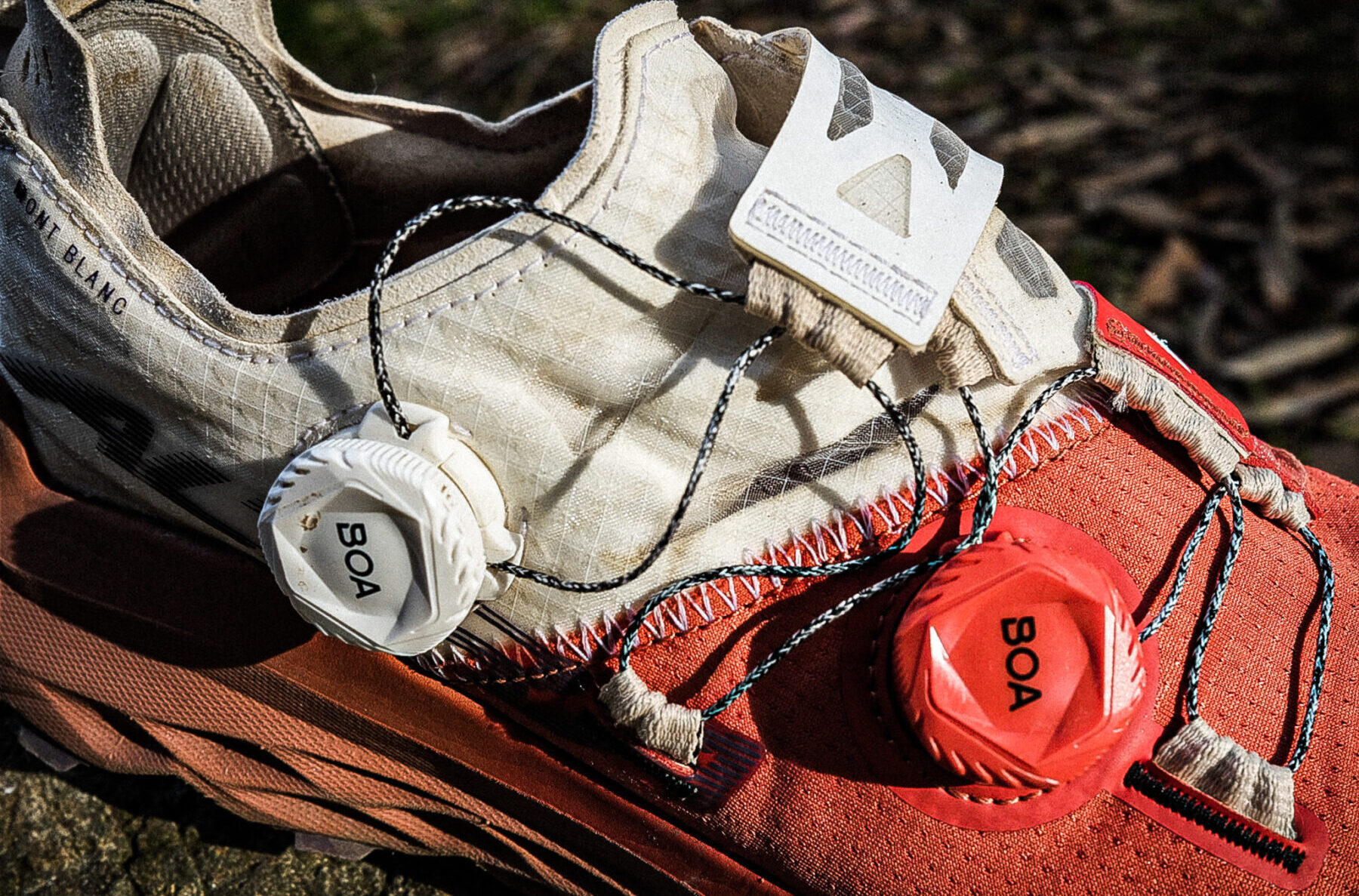
The actual laces the dials control are made of TX4, a Dyneema composite fabric that’s strong and lightweight. Using the dials is pretty straightforward, too: push down to engage it, turn to tighten, and/or pull to disengage and loosen. Apart from being smartly designed, Altra also made sure to place the dials strategically, which I think is key to the overall success of the shoe. The BOA dials lock your foot down where it’s most important — at the midfoot and heel — while still leaving ample room in the forefoot for toes to splay comfortably. The implementation of the BOA dial on a trail shoe is nothing new; however, many shoes that have used this technology tend to use a single dial. The result is a less customizable fit because the same tension is applied over the entire upper.
With the way in which the Mont Blanc BOA is constructed, the rear dial locks in the heel for maximal ankle stability, correcting a lot of the grievances aimed at the original version of the shoe. The heel counter is asked to do a lot less work supporting the foot, offloading much of its responsibility onto the BOA dials. All in all, this feels like a really solid upper design that I expect to see on a lot more shoes moving forward.
Midsole
As in several of Altra’s higher-end models for both road and trail, the Mont Blanc BOA uses their proprietary EGO MAX foam, which has been lauded for being lightweight, durable, and energetic, all at once. In fact, the Mont Blanc BOA shares a nearly identical midsole with the Timp 4, both of which deliver 30 mm worth of EGO MAX cushioning. Like the Timp 4, the Mont Blanc had noticeably more energy return than Altra shoes I’ve used with the brand’s Quantic and EGO foams and was nowhere near as forgiving as the EVA Hoka uses in models like the Speedgoat 5. EGO MAX foam is definitely in that Goldilocks zone for me; it’s not too squishy, not too firm, and the zero-drop geometry Altra uses allows for midsoles made from it to feel really consistent underfoot. All of these benefits are very much apparent in the Mont Blanc BOA.
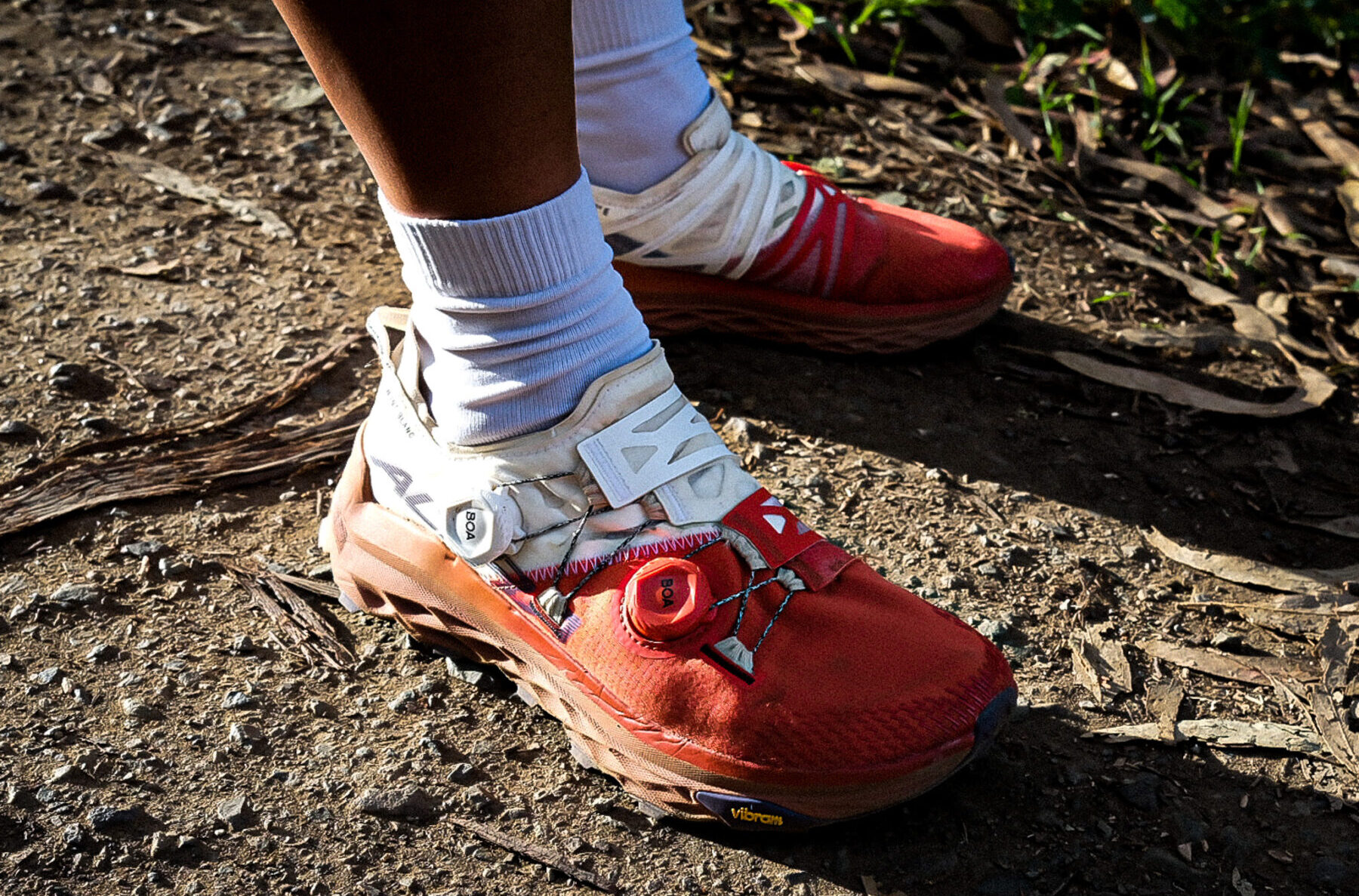
With 30 mm of stack height, the Mont Blanc BOA is a maximal trail shoe, no doubt, but it seldom felt clunky in the way that so many highly cushioned models do. Again, I think this has a lot to do with its midsole and last. Altra’s Standard width is a built-in defense against instability commonly faced by shoes with high stack heights, and the relative firmness of the Mont Blanc BOA’s EGO MAX foam, along with its flexibility, gave the shoe the trail-racer vibes it’s after while still permitting a good amount of ground feel relative to its stack height. On super rocky terrain, I still felt pretty protected, too, even though the Mont Blanc BOA lacks a true rock plate. While I’d definitely want a bit more cushioning for really really extreme efforts (runs better suited for the Olympus 5, in my opinion), I think the Mont Blanc BOA’s midsole alone should qualify it as a solid option for long-distance outings on mountainous terrain that tend to be a bit faster paced than all-day slogs.
Outsole
The Mont Blanc BOA features a Vibram MegaGrip LiteBase outsole, which is quickly becoming the tried-and-true choice for a lot of trail shoes on the market that try to optimize for performance without excess weight. This is the same outsole that’s seen on the standard Mont Blanc, an aspect of the shoe that didn’t need much tinkering. Vibram compounds are considered best-in-class by many for a reason, and Altra’s choice to use it on both the Mont Blanc and Mont Blanc BOA won’t get much criticism from me.
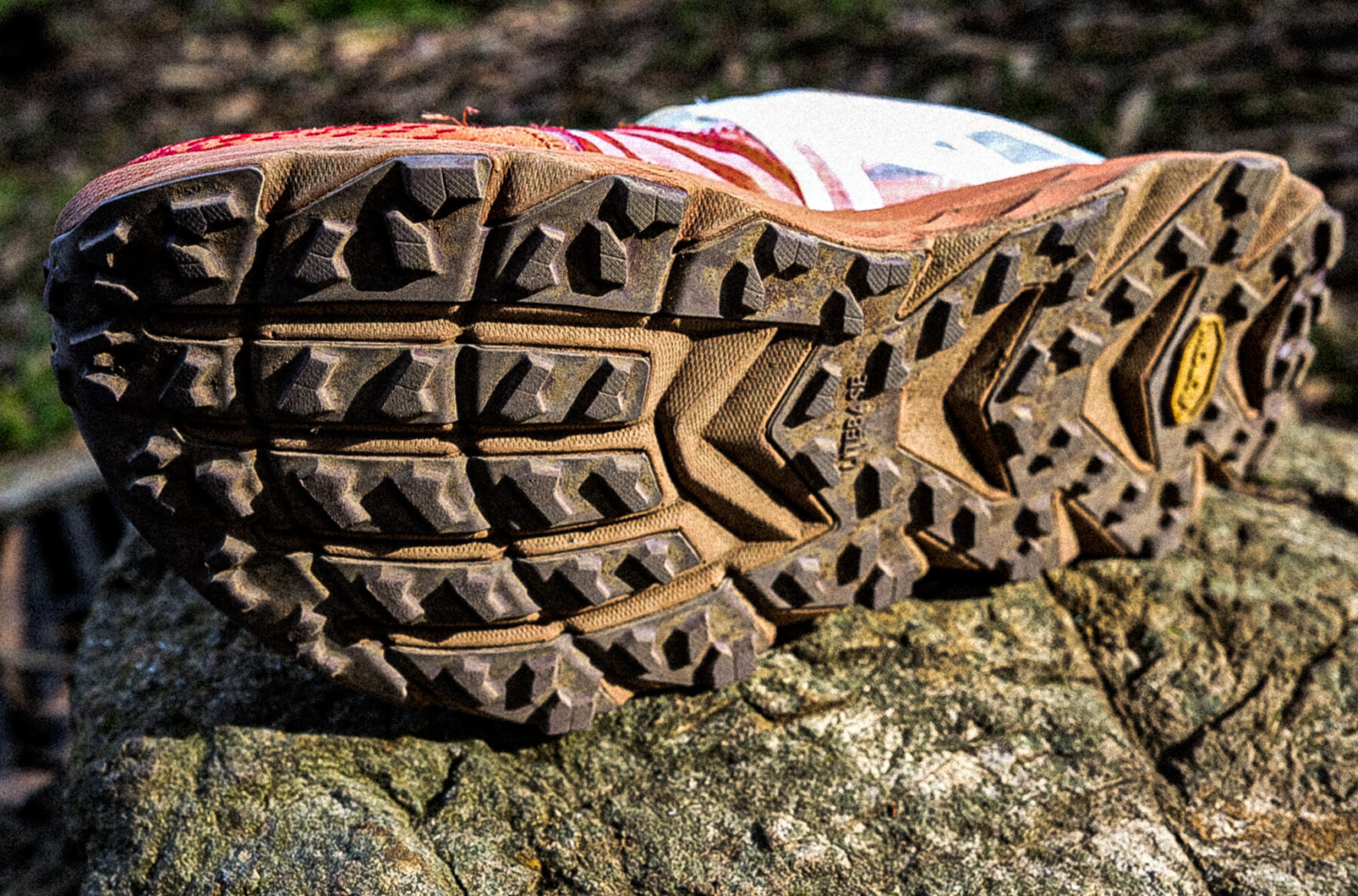
On Trail
One of the first big adventures I took the Mont Blanc BOA on was the final 18-mile loop of a 100km trail race. I’d characterize the terrain for this loop as very rugged, with plenty of off-camber trails, chunky stretches of rock-laden singletrack, and plenty of fine sand (the race was in sunny San Diego). I switched out the shoes I started in after the first 50 miles because their lack of cushioning began to beat up my feet. Once I swapped them for the Mont Blanc BOA, I felt instantaneous relief, a newfound level of comfort that I would use to propel me to the finish line. Looking back, I was really glad I went with that decision. As the terrain got even more rugged, the Mont Blanc BOA offered the perfect amount of support and comfort that I needed as my pace slowed, typical during the later stages of an ultra.
Since then, I’ve found myself reaching for the Mont Blanc BOA more than I anticipated (I own a ton of trail shoes, so I’m never short on options). For me, it strikes an excellent balance between performance and comfort, which is deceptively hard to get right. The BOA Fit System with PerformFit Wrap is slipper-like in the way it hugs my foot and Altra’s EGO MAX foam makes me feel like I’m moving efficiently even when my legs are shot. Most of my trail runs involve a concrete commute, so I’ve also enjoyed how easily the Mont Blanc BOA transitions between road and trail. While marketed for pure performance, I can easily see the Mont Blanc BOA performing a more utilitarian role as a daily trainer for runs up to any distance on pretty much every type of terrain; at least, that’s how I plan to use them moving forward.
Durability
While I’ve definitely run into issues with the build quality of certain Altra shoes in the past, usually in the form of mechanical failures like blown-out sidewalls, upper punctures, and frayed fabric, the Mont Blanc BOA has been spared of any glaring signs of wear thus far. Unlike Altra’s “MaxTrac” rubber, which I’ve found to crumble prematurely on models such as the Timp 4, I don’t have a ton of concerns about the long-term durability of the Mont Blanc BOA’s Vibram outsole, though the LiteBase version of MegaGrip that this shoe uses likely won’t hold up as long as standard MegaGrip, mostly because it is quite a bit thinner. The Mont Blanc BOA’s EGO MAX midsole foam hasn’t lost any of its energy return yet, as far as I can tell, which is a promising sign; a lot of shoes lose their spring around 100 miles, so if anything changes with respect to how the Mont Blanc BOA feels underfoot, I’ll make sure to chime back in with updates.
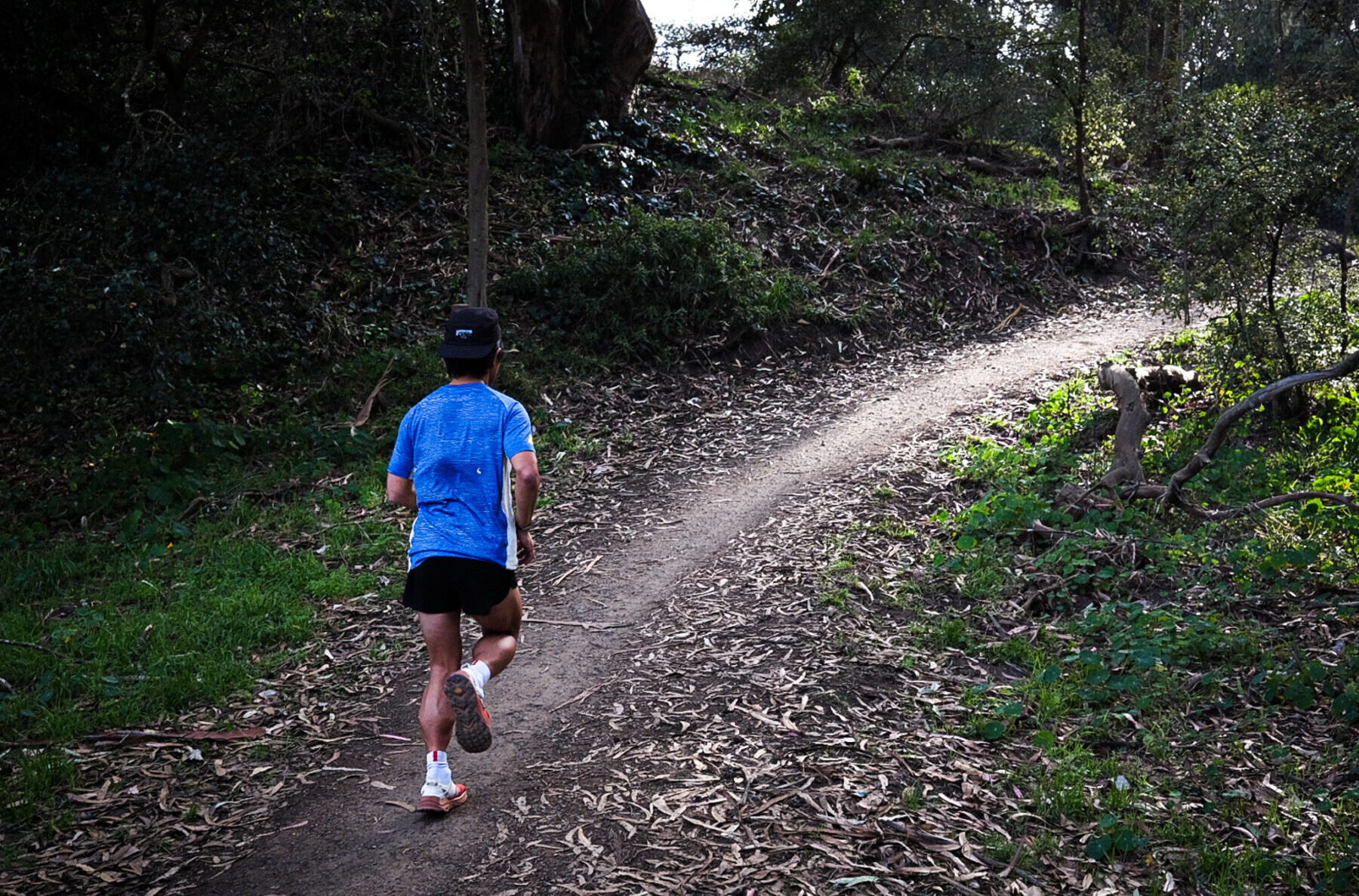
Who’s It For?
Prior to running in the Mont Blanc BOA, I never felt like Altra’s lineup offered any option specifically for race day. Most of their models felt kind of pedestrian; most lacked the performance features I felt could benefit high-stakes efforts out of caution against making the shoe too niche and limited in its uses. In the Mont Blanc BOA, Altra has managed to craft a race-ready model that’s just as comfortable tackling everyday outings. It also benefits from being built on Altra’s Standard last, which should accommodate a wide variety of foot shapes, especially those on the wider side. The addition of BOA’s Fit System and PerformFit Wrap makes the shoe more amenable to narrower foot types as well, so if you’ve had trouble with the volume of Altra shoes in the past, it’s definitely worth giving the Mont Blanc BOA a try.
Rarely does a shoe nail fit and performance as markedly as the Mont Blanc BOA does, in my opinion. Its energetic ride and the support its lacing system offers are pretty rare, though it should feel slightly familiar if you’ve spent any time in the Topo Ultraventure Pro, Altra Timp 4, or, by some fortune, the SL:PDX. It is worth noting that, like all Altra shoes, the Mont Blanc BOA has a zero-drop geometry, which can take a bit of time to get used to if you’re coming from a history of wearing models with high heel-to-toe drops. That said, if you are zero-drop curious, the Mont Blanc BOA could be a great option to get you started.
Bottom Line
Despite its seemingly niche design, the Altra Mont Blanc BOA does a lot of things really, really well. Altra offers a pretty extensive catalog of trail shoes, but the Mont Blanc BOA feels extraordinary. It’s a model that will hopefully help elevate the brand as a whole. The incorporation of BOA’s Fit System and PerformFit Wrap more than make up for the shoe’s lack of heel support and poor structure by improving the overall fit of the upper, not to mention the level of precision and efficiency they also add. The Mont Blanc BOA is a shoe to get excited about, whether you’re looking for a race-day option for mountain ultras or just want a high-performing and comfortable model suitable for most distances and types of terrain. This model represents what I think is a new chapter for Altra; I can’t wait to see what they come out with next.

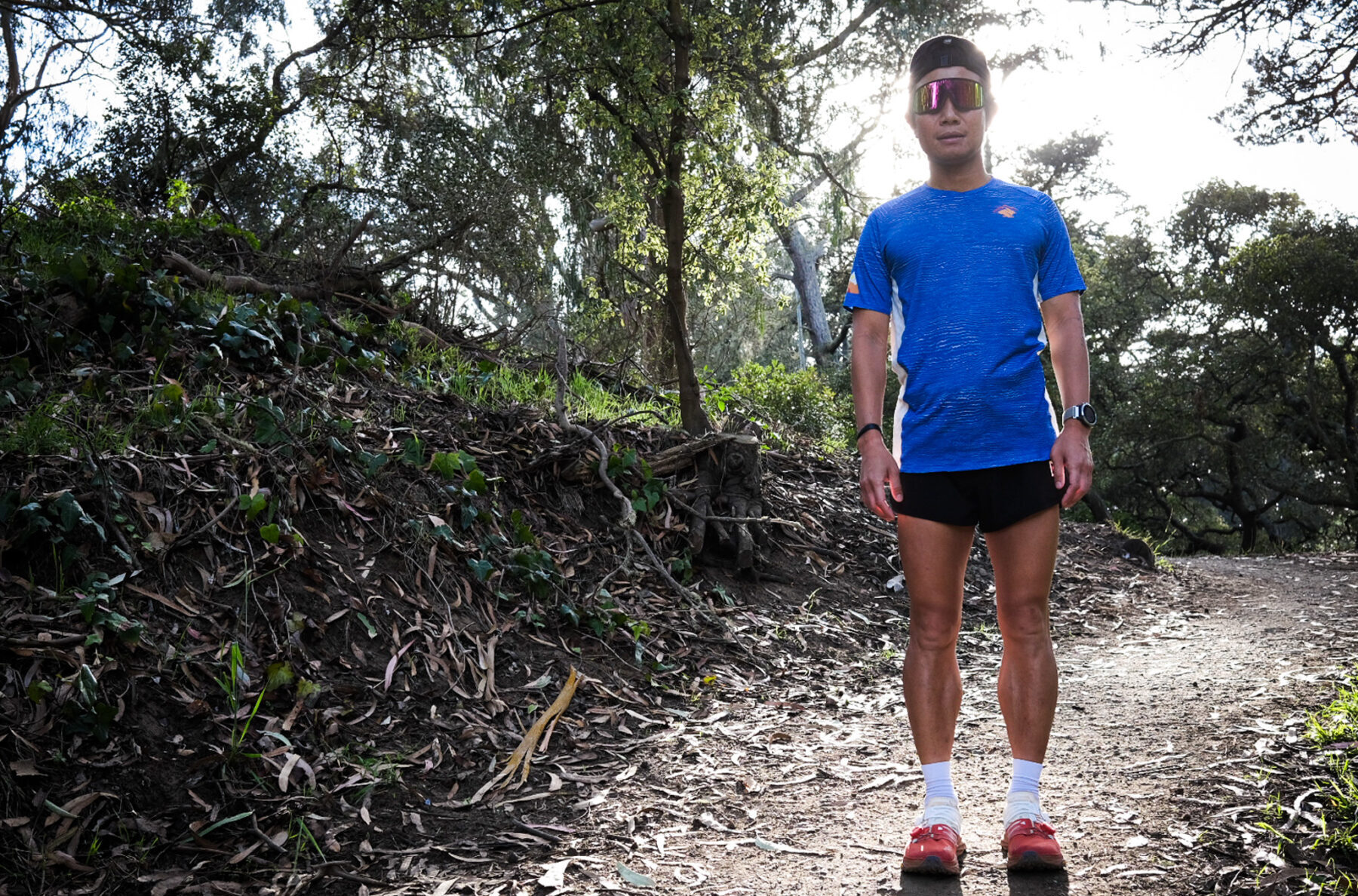
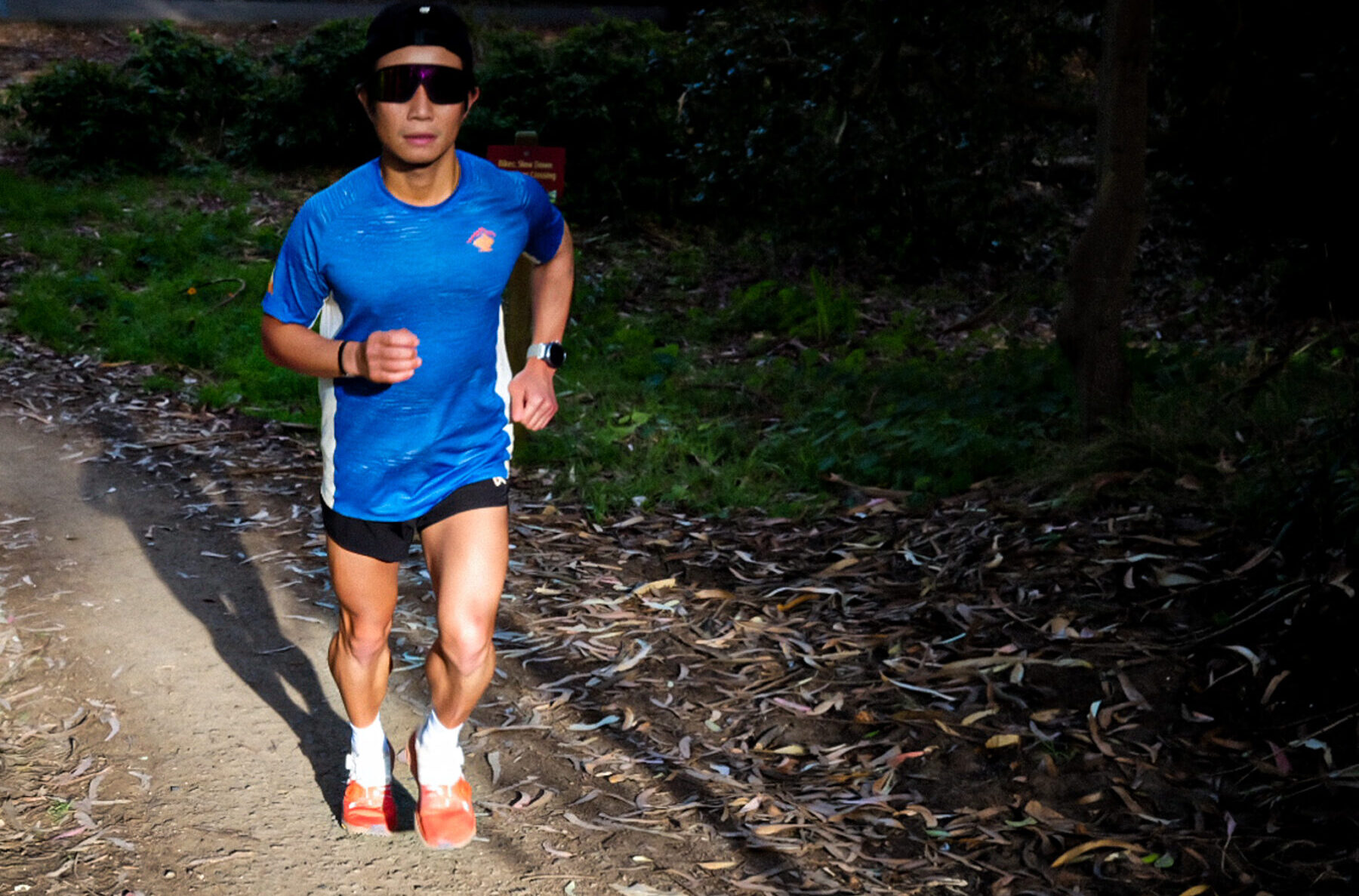

The only gripe i have to throw in here is the lower boa…its pretty noticeable and rubbing against the foot from the side. I dont see any benefits from the lower boa since the last is pretty narrow and the upper boa could be Used for the entire lacing system of the shoe as well (perfectly ecexuted in the LS Cyklones for example!) There is no benefit in spreading the dialing in two sections imao, cause, well try the cyclones…no need for a second boa, EVER…it would save 15-20 grams, would be way more comfy to ride, especially downhills, and would sleek out the overall Design even more just to use only the upper boa….rip it off and check it out- the shoes are twice as comfy!!!